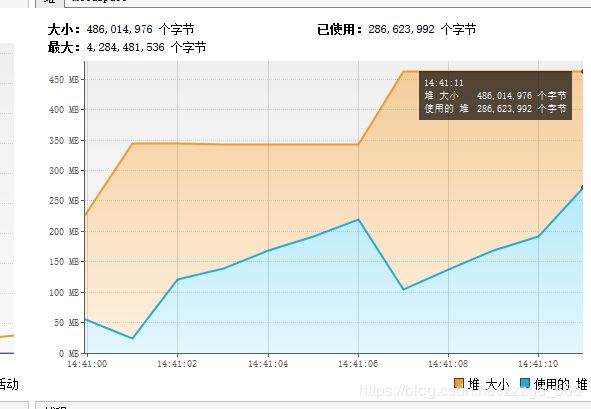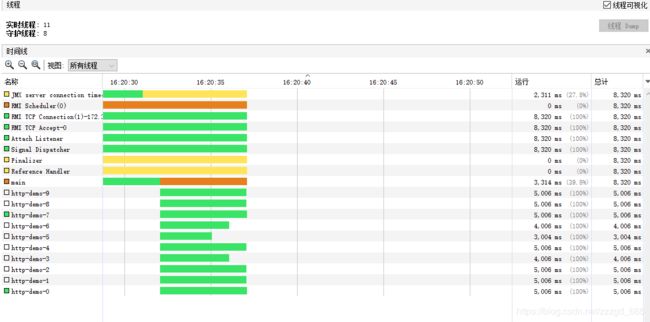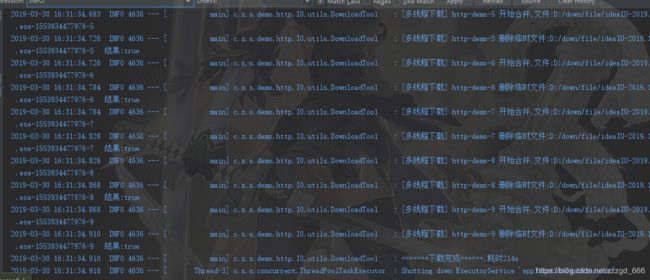Java8环境下使用restTemplate单/多线程下载大文件和小文件
Java8环境下使用restTemplate单/多线程下载大文件和小文件
- 0. 准备工作
- 1. 简单的下载文件
- 2. 单线程大文件下载
- 3. 多线程下载
0. 准备工作
下面使用的restTemplate, 都是使用整合了HttpClient连接池的restTemplate, 关于整合可以看我的上一篇文章 ,当然直接使用原生的也是可以的
我这里还使用了VisualVm Launcher的idea插件,来查看运行时的内存够和线程
1. 简单的下载文件
这里使用的是restTemplate调用getForEntity, 获取到字节数组, 再将字节数组通过java8的Files工具类的write方法, 直接写到目标文件.
这里需要注意的点是:
- 会将文件的字节数组全部放入内存中, 及其消耗资源
- 注意目标文件夹不存在,需要手动创建文件夹的问题, 注意生成目标路径的时候,斜杠
\的处理问题
代码如下:
import lombok.extern.slf4j.Slf4j;
import org.springframework.http.HttpMethod;
import org.springframework.http.MediaType;
import org.springframework.http.ResponseEntity;
import org.springframework.stereotype.Component;
import org.springframework.util.CollectionUtils;
import org.springframework.web.client.RequestCallback;
import org.springframework.web.client.ResponseExtractor;
import org.springframework.web.client.RestTemplate;
import org.springframework.web.util.UriComponentsBuilder;
import javax.annotation.Resource;
import java.io.IOException;
import java.nio.file.Files;
import java.nio.file.Paths;
import java.time.Instant;
import java.time.temporal.ChronoUnit;
import java.util.Arrays;
import java.util.Map;
import java.util.Objects;
/**
* @Author: zgd
* @Date: 2019/3/29 10:49
* @Description:
*/
@Component
@Slf4j
public class WebFileUtils {
/**
* 使用自定义的httpclient的restTemplate
*/
@Resource(name = "httpClientTemplate")
private RestTemplate httpClientTemplate;
/**
* 下载小文件,采用字节数组的方式,直接将所有返回都放入内存中,容易引发内存溢出
*
* @param url
* @param targetDir
*/
public void downloadLittleFileToPath(String url, String targetDir) {
downloadLittleFileToPath(url, targetDir, null);
}
/**
* 下载小文件,直接将所有返回都放入内存中,容易引发内存溢出
*
* @param url
* @param targetDir
*/
public void downloadLittleFileToPath(String url, String targetDir, Map<String, String> params) {
Instant now = Instant.now();
String completeUrl = addGetQueryParam(url, params);
ResponseEntity<byte[]> rsp = httpClientTemplate.getForEntity(completeUrl, byte[].class);
log.info("[下载文件] [状态码] code:{}", rsp.getStatusCode());
try {
String path = getAndCreateDownloadDir(url, targetDir);
Files.write(Paths.get(path), Objects.requireNonNull(rsp.getBody(), "未获取到下载文件"));
} catch (IOException e) {
log.error("[下载文件] 写入失败:", e);
}
log.info("[下载文件] 完成,耗时:{}", ChronoUnit.MILLIS.between(now, Instant.now()));
}
/**
* 拼接get请求参数
*
* @param url
* @param params
* @return
*/
private String addGetQueryParam(String url, Map<String, String> params) {
UriComponentsBuilder uriComponentsBuilder = UriComponentsBuilder.fromHttpUrl(url);
if (!CollectionUtils.isEmpty(params)) {
for (Map.Entry<String, ?> varEntry : params.entrySet()) {
uriComponentsBuilder.queryParam(varEntry.getKey(), varEntry.getValue());
}
}
return uriComponentsBuilder.build().encode().toString();
}
/**
* 创建或获取下载文件夹的路径
*
* @param url
* @param targetDir
* @return
*/
public String getAndCreateDownloadDir(String url, String targetDir) throws IOException {
String filename = url.substring(url.lastIndexOf("/") + 1);
int i = 0;
if ((i = url.indexOf("?")) != -1) {
filename = filename.substring(0, i);
}
if (!Files.exists(Paths.get(targetDir))) {
Files.createDirectories(Paths.get(targetDir));
}
return targetDir.endsWith("/") ? targetDir + filename : targetDir + "/" + filename;
}
}
这里找到一个搜狗浏览器的下载地址, 运行代码,并启动.
package com.zgd.springboot.demo.http.test;
import com.alibaba.fastjson.JSON;
import com.google.common.collect.Maps;
import com.google.common.util.concurrent.ThreadFactoryBuilder;
import com.zgd.springboot.demo.http.HttpApplication;
import com.zgd.springboot.demo.http.IO.utils.DownloadTool;
import com.zgd.springboot.demo.http.IO.utils.QiniuUtil;
import com.zgd.springboot.demo.http.IO.utils.WebFileUtils;
import com.zgd.springboot.demo.http.service.IHttpService;
import lombok.extern.slf4j.Slf4j;
import org.junit.Test;
import org.junit.runner.RunWith;
import org.springframework.boot.test.context.SpringBootTest;
import org.springframework.stereotype.Component;
import org.springframework.test.context.TestPropertySource;
import org.springframework.test.context.junit4.SpringRunner;
import javax.annotation.Resource;
import java.time.Instant;
import java.time.temporal.ChronoUnit;
import java.util.HashMap;
import java.util.concurrent.*;
/**
* @Author: zgd
* @Date: 2019/3/25 15:56
* @Description:
*/
@Component
@RunWith(SpringRunner.class)
@SpringBootTest(classes = HttpApplication.class)
@TestPropertySource("classpath:application.yml")
@Slf4j
public class SpringTest {
@Resource
private WebFileUtils webFileUtils;
@Test
public void testDownloadQiniu(){
String path = "D:/down/file/";
String url = "http://cdn4.mydown.com/5c9df131/6dcdc2f2ff1aba454f90d8581eab1820/newsoft/sogou_explorer_fast_8.5.7.29587_7685.exe";
webFileUtils.downloadLittleFileToPath(url,path);
}
}


可以看到使用内存从一开始的100多M,后面飙升到300多M. 总耗时是8533ms.
为了更好的展示这个方法对内存的占用,下载一个500M左右的Idea看看
String url = "https://download.jetbrains.8686c.com/idea/ideaIU-2019.1.exe";

可以看到占用内存一度达到900多M, 这才下载500M的软件,如果我们需要服务器下载几G的文件,内存肯定是不够用的.
至于下载时间,速度是300k/s左右,实在没耐心等500M的下载了
2. 单线程大文件下载
既然上面的方法只能下载小文件,那么大文件怎么办呢? 我们使用流的方式来解决. 在上面的类里加l两个方法. 这次使用Files的copy方法来处理流.
/**
* 下载大文件,使用流接收
*
* @param url
* @param targetDir
*/
public void downloadBigFileToPath(String url, String targetDir){
downloadBigFileToPath(url,targetDir,null);
}
/**
* 下载大文件,使用流接收
*
* @param url
* @param targetDir
*/
public void downloadBigFileToPath(String url, String targetDir, Map<String, String> params) {
Instant now = Instant.now();
String completeUrl = addGetQueryParam(url, params);
try {
String path = getPathAndCreateDownloadDir(url, targetDir);
//定义请求头的接收类型
RequestCallback requestCallback = request -> request.getHeaders()
.setAccept(Arrays.asList(MediaType.APPLICATION_OCTET_STREAM, MediaType.ALL));
// getForObject会将所有返回直接放到内存中,使用流来替代这个操作
ResponseExtractor<Void> responseExtractor = response -> {
// Here I write the response to a file but do what you like
Files.copy(response.getBody(), Paths.get(path));
// downloadByByteBuffer(path, response);
return null;
};
httpClientTemplate.execute(completeUrl, HttpMethod.GET, requestCallback, responseExtractor);
} catch (IOException e) {
log.error("[下载文件] 写入失败:", e);
}
log.info("[下载文件] 完成,耗时:{}", ChronoUnit.MILLIS.between(now, Instant.now()));
}
先试试那个50M的搜狗浏览器:
看到内存基本保持在100M左右,总耗时:5514ms


再试试那个500M的Idea:内存基本稳定在150M以内,下载速度也是300kb/s左右


可以看得出, 使用流的方式还是可以很好的保证内存资源不会崩掉的
3. 多线程下载
上面虽然把大文件的问题解决了 ,但是下载速度300k/s实在是太慢了.虽然小文件还是可以达到5s左右下载完50M,但是大文件还是需要更快的下载速度(下载速度也取决于当前的运营商网速和资源)
主要就是先调用一次HEAD方法去获取到文件大小, 我这里默认开启了10个线程,然后每个线程分配好下载的数据量,在请求头中设置Range属性,分别去下载属于它那一部分的数据,然后最后合并成一个文件
直接上代码吧:
package com.zgd.springboot.demo.http.IO.utils;
import com.google.common.collect.Lists;
import com.google.common.util.concurrent.ThreadFactoryBuilder;
import lombok.extern.slf4j.Slf4j;
import org.springframework.http.*;
import org.springframework.stereotype.Component;
import org.springframework.util.Assert;
import org.springframework.web.client.RequestCallback;
import org.springframework.web.client.ResponseExtractor;
import org.springframework.web.client.RestTemplate;
import javax.annotation.Resource;
import java.io.File;
import java.io.IOException;
import java.io.RandomAccessFile;
import java.nio.file.Files;
import java.nio.file.Paths;
import java.util.ArrayList;
import java.util.Arrays;
import java.util.Collections;
import java.util.Objects;
import java.util.concurrent.*;
/**
* Created by yangzheng03 on 2018/1/16. https://www.dubby.cn/
*/
@Component
@Slf4j
public class DownloadTool {
/**
* 使用自定义的httpclient的restTemplate
*/
@Resource(name = "httpClientTemplate")
private RestTemplate httpClientTemplate;
@Resource
private WebFileUtils webFileUtils;
/**
* 线程最小值
*/
private static final int MIN_POOL_SIZE = 10;
/**
* 线程最大值
*/
private static final int MAX_POOL_SIZE = 100;
/**
* 等待队列大小
*/
private static final int WAIT_QUEUE_SIZE = 1000;
/**
* 线程池
*/
private static ExecutorService threadPool;
private static final int ONE_KB_SIZE = 1024;
/**
* 大于20M的文件视为大文件,采用流下载
*/
private static final int BIG_FILE_SIZE = 20 * 1024 * 1024;
private static String prefix = String.valueOf(System.currentTimeMillis());
public void downloadByMultiThread(String url, String targetPath, Integer threadNum) {
long startTimestamp = System.currentTimeMillis();
//开启线程
threadNum = threadNum == null ? MIN_POOL_SIZE : threadNum;
Assert.isTrue(threadNum > 0, "线程数不能为负数");
ThreadFactory factory = new ThreadFactoryBuilder().setNameFormat("http-down-%d").build();
threadPool = new ThreadPoolExecutor(
threadNum, MAX_POOL_SIZE, 0, TimeUnit.MINUTES,
new LinkedBlockingDeque<>(WAIT_QUEUE_SIZE), factory);
boolean isBigFile;
//调用head方法,只获取头信息,拿到文件大小
long contentLength = httpClientTemplate.headForHeaders(url).getContentLength();
Assert.isTrue(contentLength > 0,"获取文件大小异常");
isBigFile = contentLength >= BIG_FILE_SIZE;
if (contentLength > 1024 * ONE_KB_SIZE) {
log.info("[多线程下载] Content-Length\t{} ({})", contentLength, (contentLength / 1024 / 1024) + "MB");
} else if (contentLength > ONE_KB_SIZE) {
log.info("[多线程下载] Content-Length\t{} ({})", contentLength, (contentLength / 1024) + "KB");
} else {
log.info("[多线程下载] Content-Length\t" + (contentLength) + "B");
}
ArrayList<CompletableFuture<DownloadTemp>> futures = Lists.newArrayListWithCapacity(threadNum);
String fileFullPath;
RandomAccessFile resultFile;
try {
fileFullPath = webFileUtils.getPathAndCreateDownloadDir(url, targetPath);
//创建目标文件
resultFile = new RandomAccessFile(fileFullPath, "rw");
log.info("[多线程下载] Download started, url:{}\tfileFullPath:{}", url, fileFullPath);
//每个线程下载的大小
long tempLength = (contentLength - 1) / threadNum + 1;
long start, end;
int totalSize = 0;
for (int i = 0; i < threadNum && totalSize < contentLength; ++i) {
//累加
start = i * tempLength;
end = start + tempLength - 1;
totalSize += tempLength;
log.info("[多线程下载] start:{}\tend:{}", start, end);
DownloadThread thread = new DownloadThread(httpClientTemplate, i, start, end, url, fileFullPath, isBigFile);
CompletableFuture<DownloadTemp> future = CompletableFuture.supplyAsync(thread::call, threadPool);
futures.add(future);
}
} catch (Exception e) {
log.error("[多线程下载] 下载出错", e);
return;
} finally {
threadPool.shutdown();
}
//合并文件
futures.forEach(f -> {
try {
f.thenAccept(o -> {
try {
log.info("[多线程下载] {} 开始合并,文件:{}", o.threadName, o.filename);
RandomAccessFile tempFile = new RandomAccessFile(o.filename, "rw");
tempFile.getChannel().transferTo(0, tempFile.length(), resultFile.getChannel());
tempFile.close();
File file = new File(o.filename);
boolean b = file.delete();
log.info("[多线程下载] {} 删除临时文件:{}\t结果:{}", o.threadName, o.filename, b);
} catch (IOException e) {
e.printStackTrace();
log.error("[多线程下载] {} 合并出错", o.threadName, e);
}
}).get();
} catch (Exception e) {
log.error("[多线程下载] 合并出错", e);
} finally {
threadPool.shutdown();
}
});
try {
resultFile.close();
} catch (IOException e) {
log.error("关闭文件流失败: ",e);
}
long completedTimestamp = System.currentTimeMillis();
log.info("=======下载完成======,耗时{}",
isBigFile ? (completedTimestamp - startTimestamp) / 1000 + "s" : (completedTimestamp - startTimestamp) + "ms");
}
public static class DownloadThread implements Callable<DownloadTemp> {
private int index;
private String filePath;
private long start, end;
private String urlString;
private RestTemplate httpClientTemplate;
private boolean isBigFile;
DownloadThread(RestTemplate restTemplate, int index, long start, long end, String url, String fileFullPath, boolean isBigFile) {
this.httpClientTemplate = restTemplate;
this.urlString = url;
this.index = index;
this.start = start;
this.end = end;
this.isBigFile = isBigFile;
Assert.hasText(fileFullPath, "文件下载路径不能为空");
this.filePath = String.format("%s-%s-%d", fileFullPath, prefix, index);
}
@Override
public DownloadTemp call() {
//定义请求头的接收类型
try {
if (isBigFile) {
downloadBigFile();
} else {
downloadLittleFile();
}
} catch (Exception e) {
log.error("[线程下载] 下载失败:", e);
}
DownloadTemp downloadTemp = new DownloadTemp();
downloadTemp.index = index;
downloadTemp.filename = filePath;
downloadTemp.threadName = Thread.currentThread().getName();
log.info("[线程下载] \tcompleted.");
return downloadTemp;
}
/**
* 下载小文件
*
* @throws IOException
*/
private void downloadLittleFile() throws IOException {
HttpHeaders headers = new HttpHeaders();
headers.set(HttpHeaders.RANGE, "bytes=" + start + "-" + end);
headers.setAccept(Collections.singletonList(MediaType.ALL));
headers.setContentType(MediaType.APPLICATION_OCTET_STREAM);
ResponseEntity<byte[]> rsp = httpClientTemplate.exchange(urlString, HttpMethod.GET, new HttpEntity<>(headers), byte[].class);
log.info("[线程下载] 返回状态码:{}", rsp.getStatusCode());
Files.write(Paths.get(filePath), Objects.requireNonNull(rsp.getBody(), "未获取到下载文件"));
}
/**
* 下载大文件
*
* @throws IOException
*/
private void downloadBigFile() {
RequestCallback requestCallback = request -> {
HttpHeaders headers = request.getHeaders();
headers.set(HttpHeaders.RANGE, "bytes=" + start + "-" + end);
headers.setAccept(Arrays.asList(MediaType.APPLICATION_OCTET_STREAM, MediaType.ALL));
headers.setContentType(MediaType.APPLICATION_OCTET_STREAM);
};
// getForObject会将所有返回直接放到内存中,使用流来替代这个操作
ResponseExtractor<Void> responseExtractor = response -> {
// Here I write the response to a file but do what you like
Files.copy(response.getBody(), Paths.get(filePath));
log.info("[线程下载] 返回状态码:{}", response.getStatusCode());
return null;
};
httpClientTemplate.execute(urlString, HttpMethod.GET, requestCallback, responseExtractor);
}
}
private static class DownloadTemp {
private int index;
private String filename;
private String threadName;
}
}
下载那个50M的搜狗浏览器, 耗时5s, 因为这个类里面我判断了20M以上为大文件,采用上面的流的方式下载,所以这里内存基本100到200M之间.


下载500M的Idea试试看,可以看到内存还是保持在200M以内,速度的话达到3M/s, 总共花了200多秒也就是4分钟左右下完.


